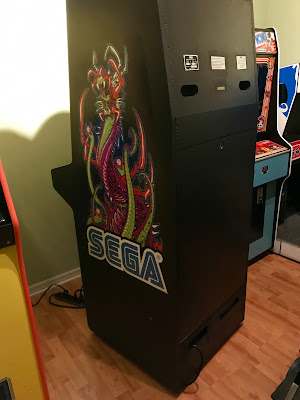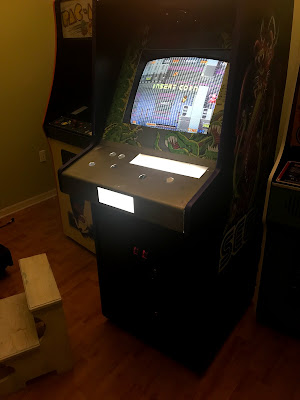Alas on to the boring stuff, or perhaps very boring, depending on your personal interests.
As much as I don't enjoy working with the coin doors, it's something that just has to be completed. This one had been lightly coated with flat black spray paint. I can't say I blame the previous owner for this, its a quick way to tidy things up. Still the door had its share of scratches and dings, and you could see where over the years, many people tried and possibly succeeded in prying open the doors with a screwdriver. The coin return buttons were wrong, they were from an Atari cabinet, and the 25 cent paper inserts had been soaked in soda at some point. Leaving it like this just wouldn't be setting a good example for the young folks.

I started by removing the coin door and taking it completely apart. The coin box was also pretty dirty and had some rust spots on the inside. I saved the old coin door label and after cleaning up the coin box, glued it back into position under the test and service switches. I soaked the yellowed plastic coin bucket in bleach water over night, and this brightened it up considerably.
For the individual coin doors, I used a small tack hammer to level out the bent edges and any dents on the front, then painted them with one coat of Rustoleum Hammered finish and then a coat of simi-gloss black. Obviously the best course of action would be to have this sand blasted and powder coated, and I sometimes do that, but this time I decided to take the quick and dirty route.
I soaked the coin return and coin slot parts in soapy water over night and did my best to remove the remaining spray paint, then treated the plastic with Marine 303 vinyl protectant. Digging through my stash of arcade parts, I found a new set of red coin return buttons that worked perfectly for this version. I soaked the springs and other lightly rusted screws in vinegar for a few hours, and this removed the rust.
For the various parts of the coin return brackets, I decided just to clean them up, and reassemble. I learned by asking the folks on KLOV, that this yellowish/gold finish is zink with yellow chromate. Things of this era were plated with zinc and chromate, but several years previous to this, from what I learned, they were using cadmium which is relatively dangerous to handle. You certainly wouldn't want to start sanding it or handling the parts without safety equipment.
Whenever I start cleaning up a cabinet for the first time, I save any unidentified parts I find laying in the bottom of the cabinet. This turned out to be good practice, as the coin door was missing some parts, and I was able to locate them in the random bits I had previously saved.
None of the cam locks came with this cabinet, and the back door, as usually happens, was being held shut with drywall screws. So for the coin door, I ordered a 4 pack of 7/8" cam locks with matching keys from Amazon. On the inside of the top door, the original extra key hook was still in place, so I added a set of keys there for originality.
Using some Bondo spot putty, I patched and sanded up the holes and any deep scratches on the back door, then repainted with a water based black satin paint, using a foam roller.
Over the course of a few evenings, I rewired the inside of the cabinet. After running the wire harness through the dishwasher it was sparkly clean. Using the pictures I took months ago, I was able to route the cables to their original locations, and used identical tiny white zip-ties to reattach everything.
With everything else done, I couldn't avoid the control panel any longer. I knew this part was going to be tedious, and I had been dreading it. It actually looks good in this picture, but the plexiglass panel in the instructions area is cracked and damaged, and there are various holes from the previously attached clear plastic cover.
I began by placing the panel in the sun to heat up, and then did my best to peel off the old overlay. To my surprise, most of it came up relatively easy. It was the colored bits that posed the most problem. I used a narrow paint scraper and removed what I could.
This left me with a control panel and a thick coating of adhesive. After trying various things, I settled on placing the whole panel in a plastic bin, and coating it with a product called CitriStrip. After soaking in CitriStrip overnight, the adhesive was easy enough to scrape off. I then had to scrub the panel down with Dawn dish washing detergent. I cleaned up a few rust spots with sand paper and prepped it for applying the overlay.
Lastly, I approached the matter of replacing the plexiglass control panel windows. These allow light to shine through, and illuminate the instructions and the Sega logo on the front. It's a nice touch, but the thin plexi panels didn't fair so well over the years. The largest one was cracked and badly damaged. I set about trying to 3d print a replacement for it.
I modeled it up in Fusion 360 then printed it in a clear PETG filament. Obviously it wasn't going to be clear, but I think it will work well enough. After three attempts, adjusting the thickness and dimensions, I managed to get a perfectly fitting piece to replace the damaged panel.
So that's all for now. I'll save applying the control panel overlay for a day when I'm totally rested and ready to take it on.


























